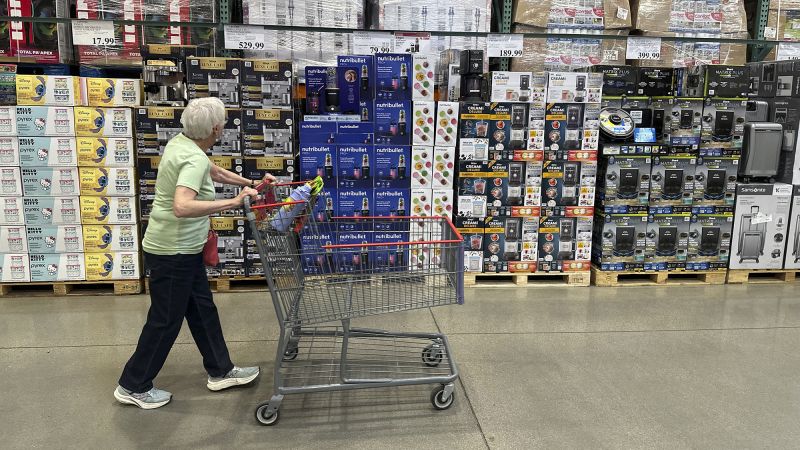How American consumers feel the pressure, in 4 graphs

CNN
—
The lingering effects of high inflation coupled with high interest rates have made it more difficult in recent years for many Americans to succeed. financially.
THE the hits keep coming.
A a series of political measures The measures adopted by the Trump administration, including particularly high tariffs that could lead to higher prices, and the heavy-handed approach taken, have fueled uncertainty and sent confidence falling to some of the lowest levels on record.
This combination of rising prices, uncertainty and pessimism can be downright harmful, as declines in consumer and business spending can have cascading negative effects on the job market and the economy as a whole.
The consumers who fuel the American economy with their expenses have been resilient so far – but they are increasingly dispersed.
Debt level increasesjust like payment defaults, and indicators of pressure on consumers are flashing red: for example, a growing number of people are paying for their groceries in several installments.
Among those who feel the most pressure are student loan borrowers who have been mired in confusion since the pandemic and amid the conflicting desires of the two presidential administrations regarding these unpaid balances. The prospects of greatly reduced monthly payments and, above all, of debt cancellation have faded; Instead, those who fell behind on their payments not only see their credit score plummet, but they also risk having their wages garnished by the government.
Here’s a quick look at how household finances are increasingly unraveling:
The Covid-19 pandemic has upended the US economy – but in doing so, some Americans have been able to respond quickly. pay off their debt and put money aside in their savings.
Stimulus checks, payment breaks (on student loans and rent, in some cases), reductions in travel and other discretionary spending, as well as a $430 billion “refinancing boom” helped give Americans plenty of dry powder and a head start on their debts.
Consolidated economies helped fuel a post-pandemic recovery, and credit card balances soared accordingly.
Record sales, on their own, are not necessarily a troublesome indicator. Credit card use is increasing as the population grows, more people shop online, and the economy and wage gains remain strong.
However, the post-pandemic recovery has included a period of high inflation for decades that the Federal Reserve tried to combat with high interest rates for decades.
Where the rubber meets the road is how people managed these growing and costly debts.
By the end of last year, Americans were increasingly struggling to manage their growing debt and, in some cases, had not been this overburdened since the aftermath of the Great Recession.
The share of households that become seriously delinquent on their auto loans and credit cards reached its highest level in 14 years.
Additionally, at the start of this year, there was strong expectation that student loan delinquencies would worsen.
The 3.5 year payment break completed in September 2023; however, an additional provision under the Biden administration included a one-year “on-ramp” during which borrowers were protected from the negative effects of a missed payment. This grace period ended on September 30, 2024, and missed payments began to affect credit reports.
Student loan delinquencies rose from 1% to 7.74% after a pandemic-era pause in reporting delinquent loans on credit reports ended, according to the Federal Reserve Bank of New York’s first quarter Household Debt and Credit Report.
“Bringing student loans back into the mix certainly seems like a bridge too far for a lot of people, in terms of their ability to pay their bills,” said Matt Schulz, chief credit analyst at LendingTree, in a recent interview with CNN.
And when loans land in serious delinquency territory (when they’re 90 days or more delinquent), it deals a blow to people’s ability to meet other goals: Defaulting borrowers with credit scores above 620 saw their average negative score move north of 140 points, and those with scores north of 720 saw a drop of 177 points on average, according to a Fed study from New York.
In addition to credit score impacts, those who have defaulted on their federal student loans will likely have their wages garnished by the Department of Education.
“The money that now has to go toward paying off student loans is money that can’t be used to pay off credit card debt, build an emergency fund, or achieve other financial goals that build a stable foundation,” Schulz said.
Buy now, pay later installment plans have become more widely available and adoption rates have increased as people of all ages – but especially young adults – have become more comfortable incorporating them into their shopping habits.
At their best, Buy Now, Pay Later loans can serve as an alternative to credit cards and are used by consumers who are looking for more flexible payment options, wanting to overcome a difficult financial situation, or looking to facilitate some larger transactions to better stick to their budget.
But it is the “at their worst” where there are greater reasons for concern.
Buy now, pay later is so simple that people can quickly spend way beyond their means, especially if they start accumulating multiple installment loans at once. A Bankrate survey conducted in May found that nearly half of all BNPL users have experienced at least one problem, with overspending topping the list.
In recent months, however, it is what people have been buying with BNPL loans that has caused concern among economists and analysts.
One in four BNPL users say they benefit from installment loans for shopping, according to surveys conducted in April and May by LendingTree. This represents an increase of 14% compared to the previous year.
There was a peak of this type of purchases when inflation hits a 40-year high in 2022.
“These loans have traditionally been designed for clothing and clothing. game consoles and furniture and things like that,” Schulz said. “But when people are using them for something as basic and fundamental as grocery shopping, it’s certainly concerning.”
“This suggests that people are looking for every possible way to stretch their budgets in the face of higher interest rates, higher prices at the grocery store and elsewhere, student loan payments and other economic headwinds that people are facing,” he added.
THE create economic headwinds weigh more on the Americans.
Consumer sentiment has been in free fall in recent monthsand in May remained at a near record levelaccording to the University of Michigan’s closely watched gauge of what people think about the economy.
Since 1952, when the university began tracking what Americans thought about the economy, there have been nearly a dozen recessions, several oil shocks, a few wars, a few inflationary episodes, a major financial crisis and a global pandemic.
It turns out that a massive trade war trumps almost everything.
Massive, high tariffs and other policy changes imposed by Trump have fueled recession fears and sent morale tumbling every month this year. The university’s consumer confidence index is down nearly 30% since January.
The biggest concern for the economy is how individuals and businesses deal with these bitter feelings and to what extent they change their behaviors.
A decline in business spending and investment could ultimately lead to a contraction of the economy and higher unemployment.
“If (consumers) look at headlines to shape their sentiment, they most likely feel like deer in the headlights — unable to move for fear that the car will swerve at the last minute,” wrote Elizabeth Renter, NerdWallet senior economist, in a commentary Friday. “Economic policy is in a state of near constant flux, and with that, so are consumers’ feelings about the economy. »
The latest Commerce Department data, however, indicates that income growth for Americans was stronger than expected in April and that people have strengthened their savings accounts. That could ultimately help people hedge against the negative effects of future tariffs, noted Gary Schlossberg, market strategist at the Wells Fargo Investment Institute.
“Strong income growth and a higher savings rate should help protect households from the brunt of inflation-related tariff increases in the coming months, leading to a ‘faint of weakness’ for the economy in the second half rather than a full-blown recession,” he wrote last week.
ـــــــــــــــــــــــــــــــــــــــــــــــــــــــــــــــــــــــــــــــــــــــــــــــــــــــــــــــــ
Soon, there will be articles covering various topics, such as:
Insurance, Loans, Mortgage, Attorney, Credit, Lawyer, Donate, Degree, Hosting, Claim, Conference Call, Trading, Software, Recovery, Transfer, Gas/Electicity, Classes, Rehab, Treatment, Cord Blood, Best mesothelioma lawyer, Truck accident lawyer, Buy life insurance online, Business VoIP provider, EMR software for clinics, Structured settlement companies, motorcycle injury lawyer, motorcycle injury attorney, spinal cord injury attorney, birth injury attorney, auto accident injury attorney, spinal cord injury lawyer, car injury attorney, motorcycle accident injury attorney, catastrophic injury lawyer, birth injury lawyer, workplace injury attorney, motorcycle injury attorneys, head injury lawyer, personal injury attorneys, traumatic brain injury attorney, train accident lawyer, brain injury attorney, auto injury attorney, serious injury attorney, personal injury lawyer, truck injury lawyer, injury attorneys, back injury lawyer, injury lawyer near me, injury lawyer,
If you would like to see these articles, please write so in the comments.




